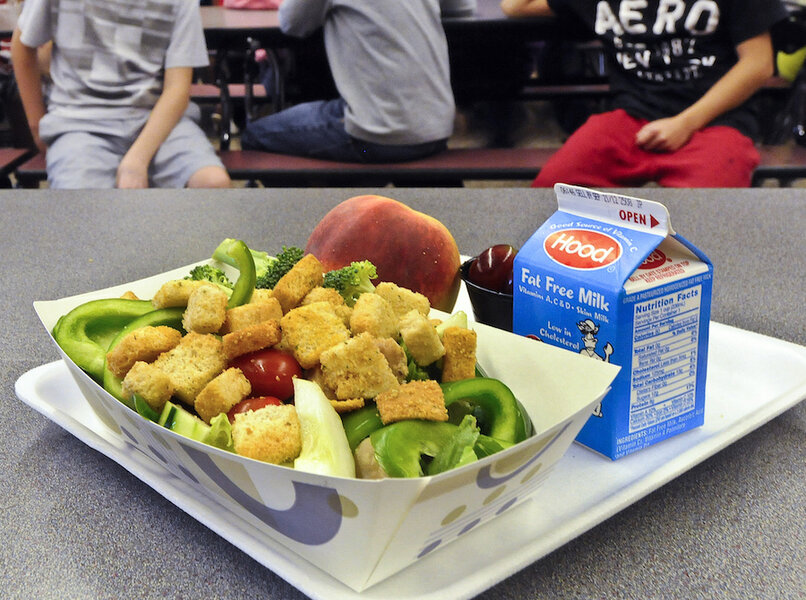We can change the food, but can we change the lunchroom?
Loading...
One day while I was volunteering at my daughter’s elementary school lunchroom at an event called “Rainbow Day”, something started to click for me. “Rainbow Days," created by our district’s food service team, introduces kids to the concept of “eating a rainbow” and helps them develop a taste for and understanding of the need to eat a variety of colors. You give the kids stickers if they can get 5 colors on their plate from the salad bar. Kids seem to really like this event, particularly the K-3 grades. You can tell just by watching how well kids are able to engage with experiential food and nutrition learning at lunch. That understanding was the start of my ‘Aha’ moment. Why is the lunchroom the only room in the school that provides NO learning opportunities? Why are kids eating in a make-shift cafeteria? Why are they given only 20 minutes to shovel food down? How could anyone get excited about food in an institutional setting like this?
In my prior for-profit life we were trained to look for market opportunities, low hanging fruit, overlooked categories. That type of critical vision is ingrained in me and has played a key role in my new non-profit world. Having worked for Whole Foods Market for nearly 13 years, one thing was very clear to me: food presentation and the environment in which you are getting your food matters. Regardless of the different food facts, quality standards and certifications - the number one reason people shopped at Whole Foods was how it made them feel when they walked in.
Looking around at the school lunchroom, the way it made me feel was yuck! Here I was at a school that was part of one of the best school food service programs in the country, all the food was cooked from scratch using fresh whole ingredients, we had salad bars in EVERY school stocked with fresh fruit and veggies…momentous! But everything in the cafeteria screamed institutional. It did not scream fresh, or food is important. Beyond the food itself there was nothing in the process of lunch that said to kids you should value this time, food is a priority, food is the single most significant thing you can think about to ensure your health and the health of the planet.
That’s when I flashed back to my Whole Foods days and the amount of time that we spent on thinking and brainstorming and innovating around how things at the stores should look and feel. All of that thought and effort came though in creating a store where not only could people buy good food, but the essence of the food could be felt through everything in the store: the tables and the chairs and the signage and the fixtures.
So what if we could convey that same feeling in our schools lunchrooms? What if where kids ate reflected the importance and the value that our society placed on food and our bodies? Now I know I might have lost some folks at this point – I realize that Whole Foods spends millions of dollars building out their stores and that they have the funds to do so. We do have to be pragmatic here, but there is a lot of room for improvement. Not only could we look at the general atmosphere promoting the value of mealtime, we could also look for opportunities for learning. It’s about time we brought the lunchroom into the overall learning goals of the school.
It’s so hard for teachers these days – they are being asked to squeeze more and more learning out of the same amount of time. The national debate over testing has endless momentum, and proponents on each side seem to be getting louder. While I firmly believe that food and nutrition education should be part of the regular school day and offered to every child in every grade, I am also a realist and understand that we have a lot to sort out with common core, national testing, and time to teach. I will never give up on pursuing national food and nutrition education in K-12, but how can we effect change NOW?
Learning Lunchrooms!
How about tables with basic facts about how your body processes a calorie? Wall signs that show what nutrients are in specific foods. Chairs that have messages about body movement needs. Salad bars that have information about ingredients and how they affect your body. Lending culinary libraries where you can take out utensils with recipes on them to make at home. What about plates and tableware that make you feel like what you are eating is of worth? What else? I know the power of collective brainstorming. If you could create something in a school lunchroom that helped kids understand the value of food or passively educate them about food or nutrition what would it be? Respond here because we are listening. We have started to explore what a learning lunchroom could look like and how it could be implemented, and we not only welcome your ideas we would be so appreciative to get them.
Lunchrooms are an overlooked part of the school environment, and they are the perfect opportunity to help support food and nutrition education in schools. The fact is that the equipment these schools buy now is not cheap, the tables and chairs and salad bars (that all look very institutional) are not cheap. We just need a better option – something that provides the same functionality but offers more. Our country is very good at business innovation. Every time we turn around there is something new and better and smarter - we can be just as good at school-based innovation if we try.







